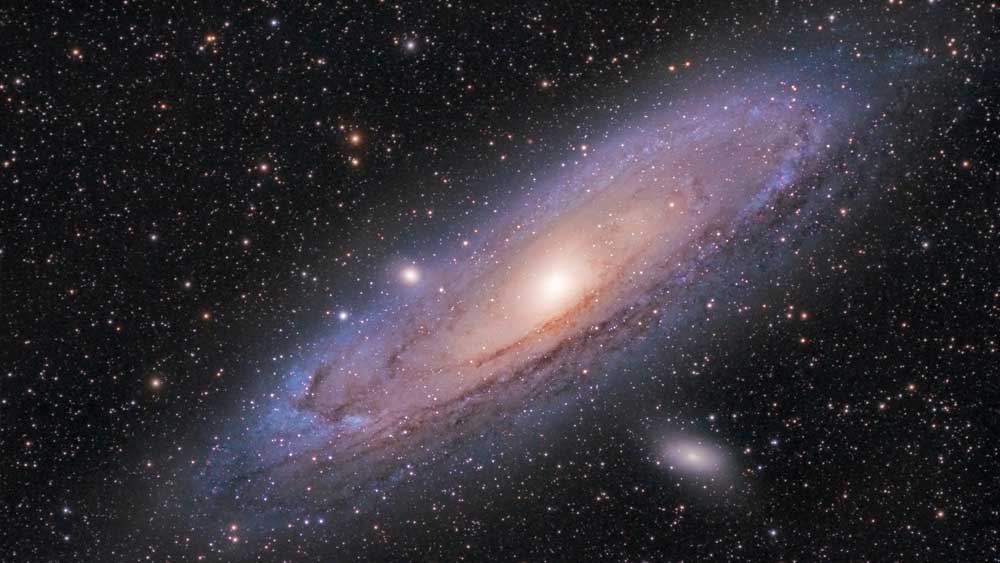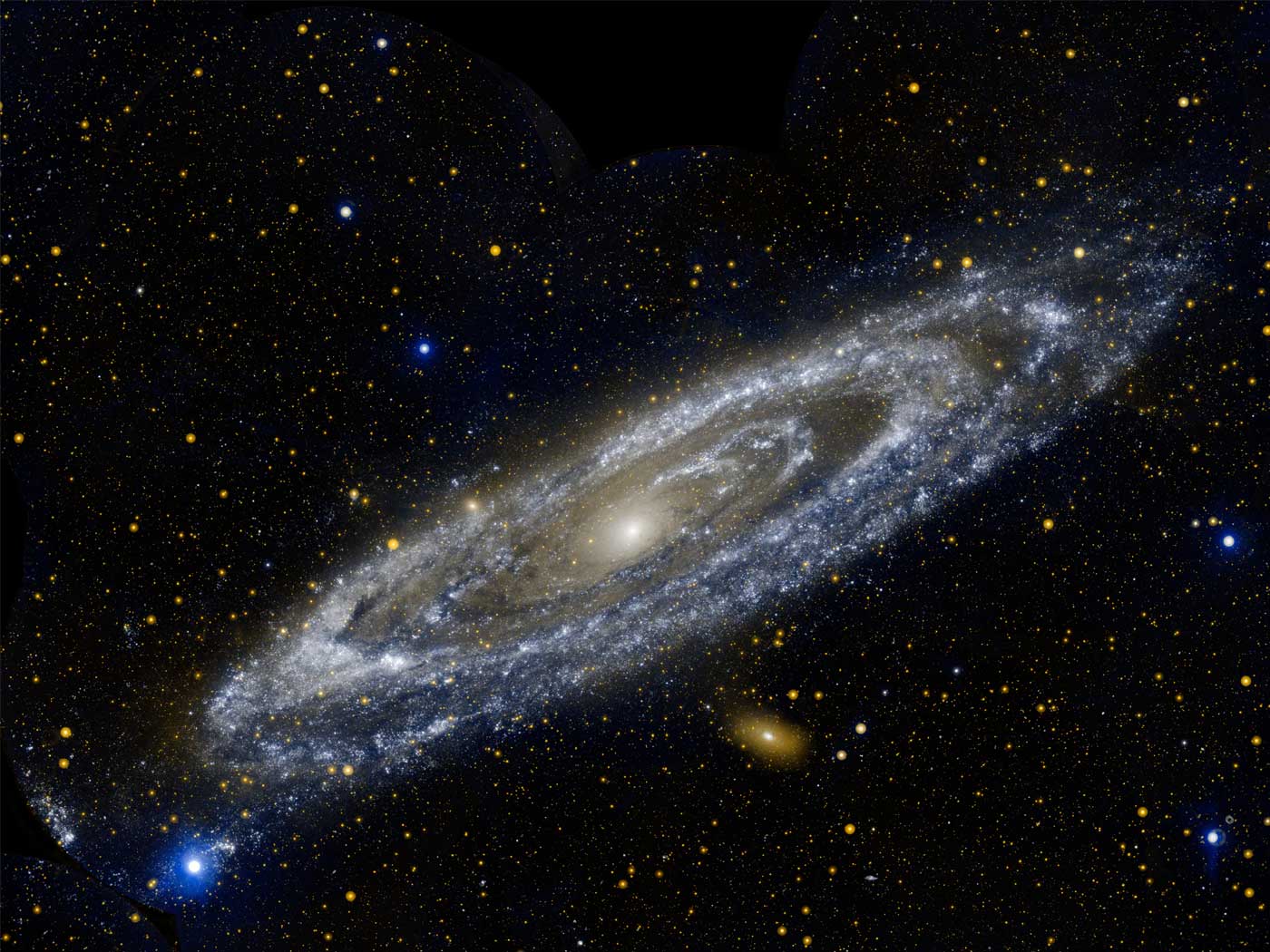The naked eye allows us to see just a little of God’s heavenly handiwork, but even this little bit clearly declares God’s glory.1 As more powerful telescopes peer deeper into space, more and more reasons to question the secular origins story accumulate.
Recently, astronomers were surprised by very distant spiral galaxies. As described in a popular science news article, “New results from an ambitious sky survey program, called ALPINE, reveal that rotating disk-shaped galaxies may have existed in large numbers earlier in the universe than previously thought.”2 These rotating galaxies were detected using data from multiple observatories, including Chile’s Atacama Large Millimeter/submillimeter Array, or ALMA. By observing Doppler shifts3 of light emitted from positively charged carbon ions within the galaxies, astronomers were able to infer that the galaxies were rotating. By secular reckoning, these galaxies would have formed between 1 and 1.5 billion years after the supposed Big Bang, or 12.2 to 12.7 billion years ago.2
Big Bang astronomers assume that light from the most distant galaxies takes billions of years to reach Earth. Indeed, this assumption is often used to challenge Bible believers. It is at the heart of the question, “If the universe is just thousands of years old, how can we see starlight from galaxies that are billions of light years away?”
However, Einstein’s theories of relativity have shown that supposedly intuitive ideas about light, space, and time are incorrect, and many creationists think that relativity theory may be the key to answering this common objection to biblical creation.
Moreover, this assumption is a double-edged sword for secular astronomers, because distant light presents problems for the Big Bang, too.
Because Big Bang astronomers assume light from the most distant galaxies takes billions of years to reach Earth, they think we are seeing these very distant galaxies, not as they are now, but as they were in the very distant past. Since galaxies supposedly take vast amounts of time to form and evolve, the most distant galaxies should appear to us to be immature and poorly developed. However, many galaxies which are extremely distant appear fully-formed or mature!4-7
Better observations will be necessary to confirm if these disk-shaped objects are true spiral galaxies. If so, this would turn out to be just one more example of this phenomenon.
It should also be noted in passing that the pinwheel-shaped arms in spiral galaxies should become tightly wound after just hundreds of millions of years, so the continued existence of spiral galaxies is an argument that they are much younger than secular scientists think.8
Are you looking for quality educational material for yourself and your family during coronavirus social distancing? ICR has numerous book and video resources available. These include our four-part DVD series The Universe: A Journey Through God’s Grand Design, which is also available via digital download.9 We also carry all three volumes of the highly popular DVD series What You Aren’t Being Told About Astronomy.10 We also have astronomy- and space-themed books, including Guide to the Universe11 and The Work of His Hands12 by astronaut Jeff Williams, as well as a number of books for younger readers.13-15
References
1. Psalm 19:1-2.2.
2. Clavin, W. Rotating galaxies galore: New results from ALPINE reveal what appear to be spiral galaxies in the infant universe. Phys.org. Posted on phys.org April 21, 2020, accessed April 22, 2020.
3. A familiar example of a Doppler shift is the increase in pitch of an approaching ambulance siren, and the decrease in the siren’s pitch as it moves away. Light can also be Doppler shifted: light spectra from sources that are moving away are shifted toward the “red” end of the spectrum, and spectra from approaching sources are shifted to the blue end of the spectrum.
4. Thomas, B. Distant Galaxies Look Too Mature for Big Bang. Creation Science Update. Posted on ICR.org November 30, 2011, accessed April 22, 2020.
5. Thomas, B. ‘Old’ Galaxy Found in ‘Young’ Part of Universe. Creation Science Update. Posted on ICR.org May 24, 2011, accessed April 22, 2020.
6. Thomas, B. Distant Galactic Cluster Should Not Exist. Creation Science Update. Posted on ICR.org May 21, 2010, accessed April 22, 2020.
7. Thomas, B. Secrets From the Most Distant Galaxy. Creation Science Update. Posted on ICR.org November 18, 2010, accessed April 22, 2020.
8. Hebert, J. 2019. Deep-Space Objects Are Young. Acts & Facts. 48 (9).
9. The Universe: A Journey Through God’s Grand Design. 2018. Dallas, TX: Institute for Creation Research. DVD.
10. Psarris, S. What You Aren’t Being Told About Astronomy, Volumes 1-3. Creation Astronomy Media. DVD.
11. Guide to the Universe. 2016. Dallas, TX: Institute for Creation Research.
12. Williams, J. 2010. The Work of His Hands. St. Louis, MO: Concordia Publishing House.
13. Staff Writers. 2017. Space: God’s Majestic Handiwork. Dallas, TX: Institute for Creation Research.
14. Turner, J. 2019. Space. Dallas, TX: Institute for Creation Research.
15. Williams, J. 2018. The Work of His Hands for Kids. St. Louis, MO: Concordia Publishing House.
*Dr. Jake Hebert is Research Associate at the Institute for Creation Research and earned his Ph.D. in physics from the University of Texas at Dallas.

"Early" Spiral Galaxy Surprise
The Latest
Was a Key to Photosynthesis Evolution Discovered?
Northern Canadian lakes were the source of recently discovered unique photosynthetic bacteria of the phylum Chloroflexota. After years of culturing,...
CREATION PODCAST
Four Moons That Indicate a Young Universe | The Creation Podcast:...
Earth has one moon, but Jupiter has many! What can we learn from our celestial neighbor's satellites? Do they indicate youth?
Host...
Creation Kids: Seeds and Sprouts
by Renée Dusseau and Susan Windsor*
You're never too young to be a creation scientist and explore our Creator's world. Kids, discover...
APOLOGETICS
Christ’s Creativity in Canyon Critters
Grand Canyon animals display many marvelous traits and behaviors as they live life in that harsh habitat. These canyon creatures succeed thanks to the...
Standing Against False Science
I’m Michael Stamp, and I’m in my 12th year as an editor at the Institute for Creation Research. It’s always an encouragement to see...
Oysters and Pre-Flood Longevity
The oyster species Crassostrea virginica, also known as the eastern oyster, is a prized seafood. Research has demonstrated that a fossil version of...
Galápagos Finches: A Case Study in Evolution or Adaptive Engineering?
A group of birds known as Darwin’s finches live in the Galápagos Islands, which are located in the Pacific Ocean 600 miles west of Ecuador....
Hot Springs National Park: Hydrothermal Springs Formed By The...
Hot Springs National Park is located about an hour southwest of Little Rock in the folded Ouachita Mountains of central Arkansas. It is the second smallest...
Why Biology Needs A Theory of Biological Design—Part 2
“Based on a true story” is included by movie producers to add authenticity, importance, and a flair of anticipation. So, my account of how...
Marine Fossil Tapeworm Is Still a Tapeworm
The Flood was both sudden and rapid. The burial of creatures—including delicate plants and soft-bodied animals like jellyfish1—occasionally...


























